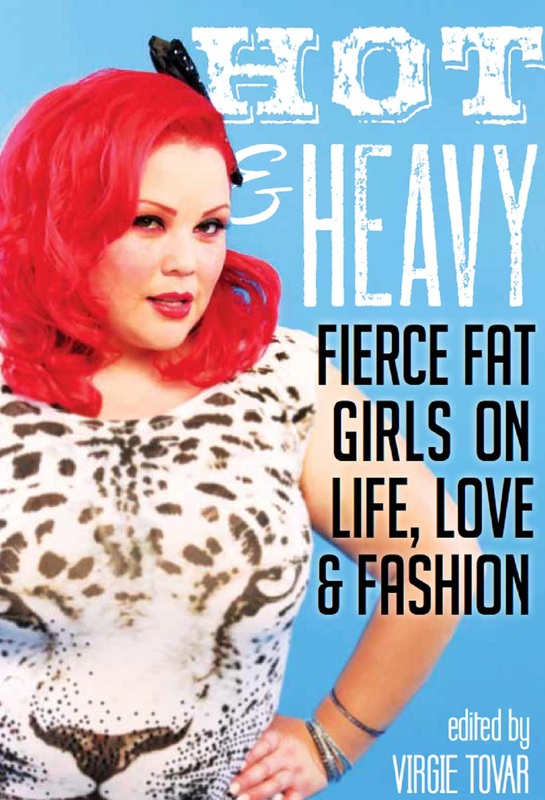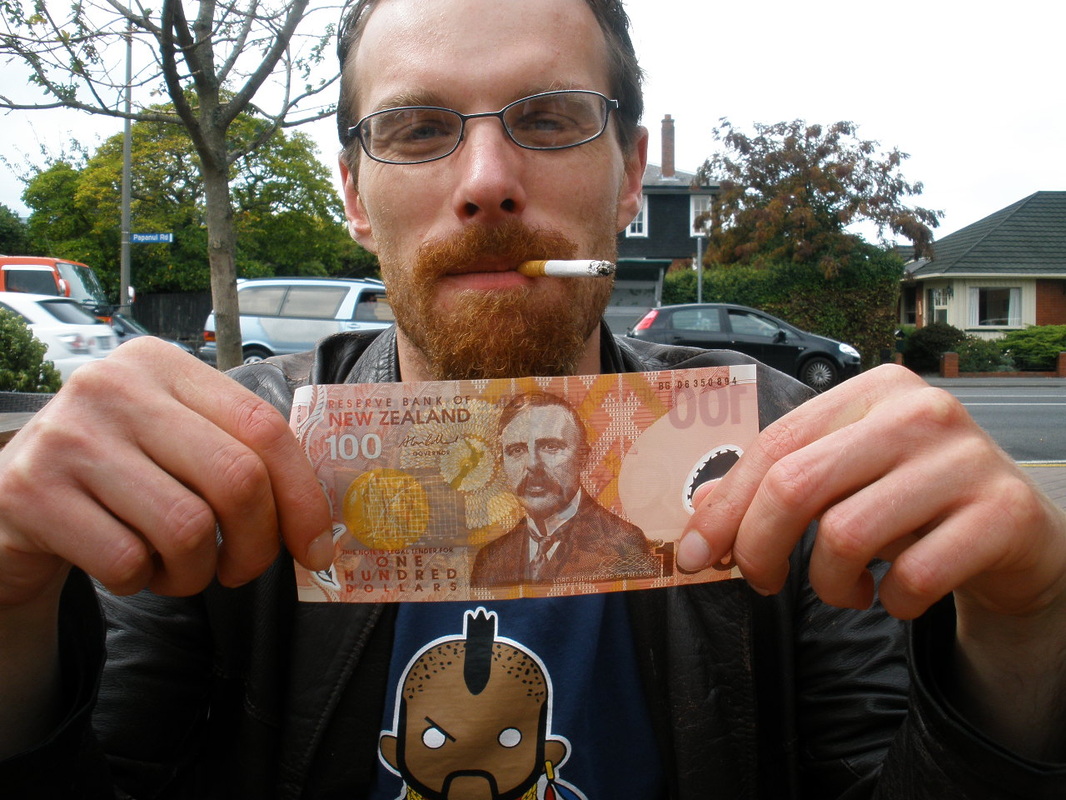|
It was last May that I was excitedly e-mailing back and forth with Seal Press about this potential anthology project that would become Hot & Heavy: Fierce Fat Girls on Life, Love and Fashion. The book didn't even have a name, and when I pitched it originally it had been an anthology exclusively about fat sexuality. I was finishing grad school and had almost lost my mind due to the strange politics and sociopaths that academia seems to attract. But I was in love with my research about fat women, and couldn't believe how much my life had changed since I started the research. But here's the back story: The idea crystallized in Rarotonga in 2009. Rarotonga, the largest of the Cook Islands, is in the middle of the Pacific Ocean. Here's my description of Raro from my chapter, "Pecan Pie, Sex & Other Revolutionary Things" in Hot & Heavy: "There women wear flowers in their hair, wardrobes are full of pinks and oranges. It is a place where shoes are optional, and glorious mouths open and big tummies rollick when women laugh. This is a magical place, where giant clams stake their place on the lagoon floors, where glow worms dance during full moons, where a prehistoric language still percusses on the tongues of every inhabitant, where papaya is perfected by humidity and sunlight, where the dragonflies are as big as hummingbirds. There’s only one road that circumnavigates Rarotonga, and lagoons are never more than ten feet away. You can touch electric blue starfish just below the water’s surface while bright yellow fish scuttle past your toes. You can pick starfruit, mangoes and coconuts from trees beside the road. Television is comprised of one channel. Dishes are made up of coconut milk and lime, raw fish and spinach, chicken cooked in an underground oven called umu. Here you wear a flower behind your left ear if you’re taken and behind your right ear if you’re single. The island is green and lush. And the women are huge." I was visiting from New Zealand, where I’d sequestered myself for five months with my boyfriend, Sam, attempting to know love, to learn something about myself, to leave San Francisco and all its hipness. I decided to do Rarotonga alone. I was playing a little game of hide and seek with the crabs as they popped in and out of their subterranean burrows, and that gave way to writing wishes in the white Pacific Island sand: if anything magical could happen by doing this kind of thing it would be in this place. Fatties of the World Unite was my first wish (I even took a picture: see below). The title changed, but the wish never did. I wanted to write a book that would change the way that we talk about fat, a book about fierce, unapologetic, sexy, sassy, ruthless, middle-finger-extended-to-the-world fat girls! At this point in the story I still hadn't been introduced to the dazzling world of fat activism. I’d been asked to write my story for a friend’s Masters thesis project on body image. The story, entitled “Fatties of the World Unite,” was about my life as a fat girl, a call to arms to women who had been impacted by this big bad word (fat), fat shame and stigma. I went to New Zealand shortly thereafter, and I got an email from my friend telling me that someone had read it and wanted to tattoo it on her body. I knew that if my little essay inspired tattoo aspirations that this was a subject that was deeply and urgently important. When I returned from the Cook Islands I immediately began to write a book proposal about fat girls and sexuality. I was a certified sex educator; I had taught female sexuality classes at UC Berkeley; I was working as a phone sex operator. My life, in short, was all about sex. I spent three full days writing with a desperate excitement. I had heard of Seal Press back when I was doing radio for a San Francisco show. We interviewed one of their authors on the show and my 23-year old self filed Seal away in the DPHA (Distant Possibility/High Aspirations) file in my brain. Now I was 27 and I sent my proposal for Fatties of the World Unite all the way from Christchurch, New Zealand to California, to Seal Press. The senior editor wrote me back about a month (or maybe three) later, telling me she liked my voice and that she would see what everyone else thought. It turned out that there were too many concerns about it not reaching the intended market. It was a no-go. Interestingly, what I got out of the exchange was not the rejection but rather the pride that the senior editor had written me and told me she liked my stuff. I also had some good news to buffer the rejection: I had been accepted to the Human Sexuality Masters program at San Francisco State University, one of the only of its kind in the world and one of two similar programs in the United States.
My thesis was entitled “How Fat Women of Color Queer the Feminine.” It was a qualitative project in which I interviewed 10 women about their lives, their bodies and their relationship to femininity. I discovered lots of things, among them that some fat women feel that they are not allowed to be "girly" in childhood because of their fatness and that this may lead to gender confusion. The stories the women I interviewed told were fascinating to me and to other scholars who found out about my work. I got lots of support and encouragement from fat activists and fat studies scholars. For my research I began to read books about fat (like Dan Kulick’s Fat: The Anthropology of an Obsession and The Fat Studies Reader) and attend fat positive events (like the NOLOSE conference). I began to host my own fat positive events. I hosted a panel at Good Vibrations, called “Hot Fat Femmes” and then another event for the San Francisco GLBT Historical Society called “Queer F’attitude.” My research in graduate school led to a journey into the “fat underground,” where fat women wore bikinis and ate dessert and had great sex and didn’t talk about diets. It was amazing and it changed my life. While I was in graduate school, fat blogs and “fatshion” were taking off. Fat Studies was actually a feature at conferences I was attending for the first time, and presentations of my research filled entire rooms with interested participants. When I was nearing graduation I wrote the senior editor of Seal again, asking if she remembered me and telling her that this fat thing was catching on. This time I had an idea for an anthology and after some negotiation I got the answer I’d hoped for back on the beaches of Rarotonga: Yes, Virginia, we will publish your book about fat girls. Once the initial shock and amazement wore off, I remembered that I had never edited an anthology before, that I was terrified, and that I had six months to overcome that and have a finished manuscript. I had meetings with other writers and mentors, most of them said I’d never get it done on time. I got in touch with bloggers, writers, vloggers, scholars, activists, big women I saw at Costco (“Hi, you look really fierce. Do you want to write for my book?”). When the submission deadline came I had close to one hundred submissions. I couldn’t believe it. For a topic that is relatively new and very taboo (increasingly taboo with the redoubled efforts of the War on Obesity), I was amazed that so many women were willing to share their stories with an unknown editor, to use this word, to be part of something so different. Editing this book has afforded me realizations and a million other things. There were nights I stayed up reading the same submission over and over, nodding with recognition, sometimes crying because the story held resonance or remembrance or regret that we shared. Their stories inspired my writing and my sense of urgency. Even though people (largely lesbian/queer feminists) have been doing what could be called “fat activism” since the 1960s, we still find ourselves at a point in history where the word is taboo, the concept unthinkable. If you are fat you could live your entire existence truly believing that you deserve nothing approaching what I call life. I had a realization early in the review process. I realized that in my desire to empower women I wanted to edit out parts of the story that made up the tales of liberation the contributors were telling. I wanted to show them only the shiny, fun bits, the bits that come after a lot of thinking and dreaming and contemplation and pain. I realized that my attempt to mask these parts of the story was my way of trying to protect readers from having to relive experiences that had hurt them, but I realized that to do that would be inauthentic. Refusal to tell the whole story is a kind of lying. The stories in the book are varied and amazing: from a woman who discovered her fat vulva in a sex class to a woman who learned her liberation over 6 days she spent naked as an artist painted her, stories that began in the home of San Francisco’s biggest coke dealer and that ended with a mother’s refusal to continue a legacy of intergenerational body shame. This book is amazing and historical, a book that will still be read in fifty years for the first or fifth time, and I’m honored to have been given the opportunity to oversee its creation. You can order Hot & Heavy: Fierce Fat Girls on Life, Love and Fashion on Amazon or buy it at your local bookstore! If you love H&H, want to support it (and books/activism like it) and spread the "glittery word of the coming revolution" you can do one or many of the following: 1. Write a review of the book or your fav chapter on your blog 2. Write a review on Amazon 3. Like it on Amazon 4. Like Hot & Heavy on Facebook (www.facebook.com/hotandheavy) 5. Take a snapshot of yourself with the cover and post it on Facebook or Twitter 6. Write your own "I'm Hot & Heavy because..." inspired post 7. Tell Virgie how H&H moved you, changed you, made you laugh or made you cry. Send to [email protected] and your response will be posted on the H&H page. 8. Ask your local/campus newspaper to run a piece on H&H 9. Do something radically delicious and thoroughly unapologetic just for you ♥ Comments are closed.
|
Virgie Tovar
Virgie Tovar, MA is one of the nation's leading experts and lecturers on fat discrimination and body image. She is the founder of Babecamp (a 4 week online course focused on helping people break up with diet culture) and the editor of Hot & Heavy: Fierce Fat Girls on Life, Love and Fashion (Seal Press, 2012). She writes about the intersections of size, identity, sexuality and politics. See more updates on Facebook. Archives
April 2021
Categories
All
|






 RSS Feed
RSS Feed